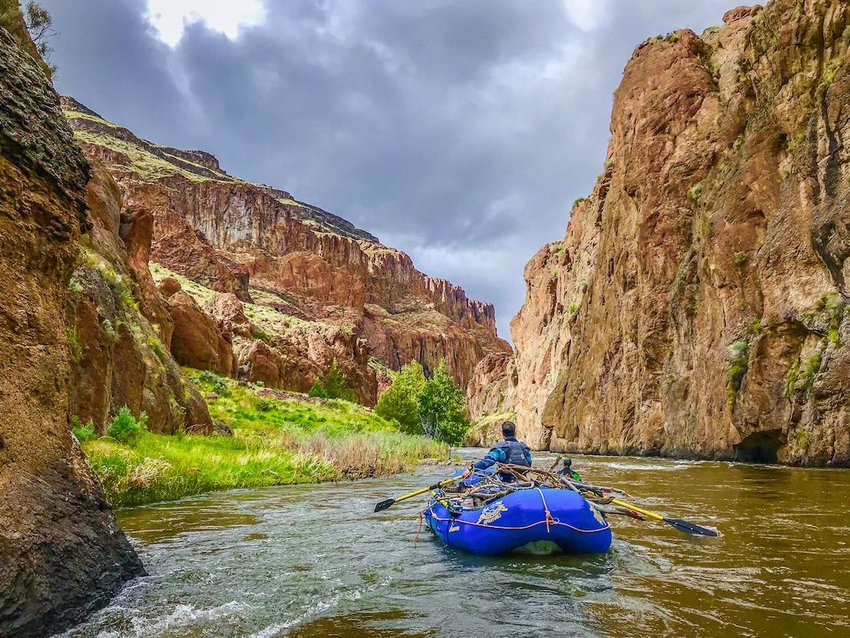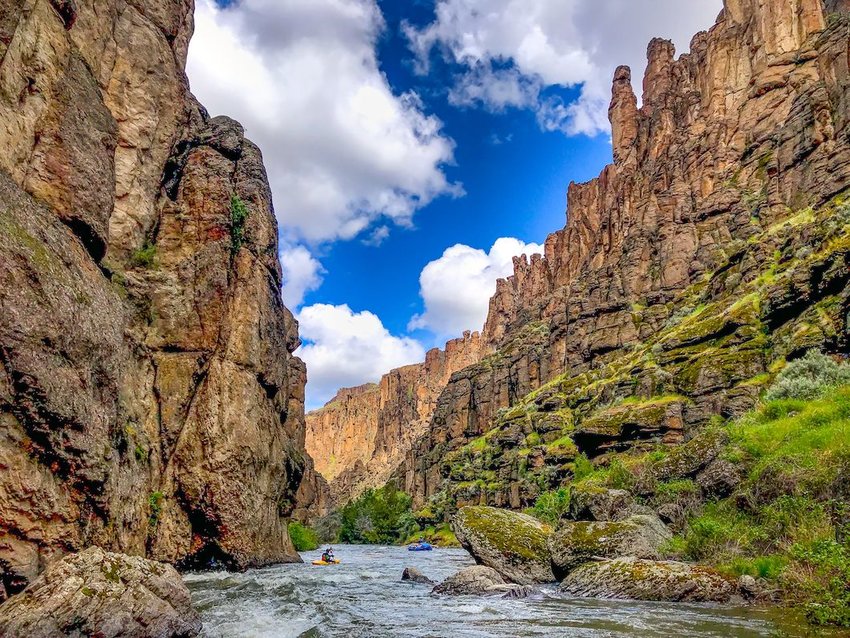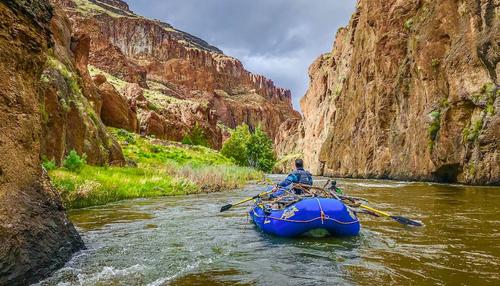The Jarbidge-Bruneau was ranked among the top 10 adventures in the world by National Geographic. This spring, I rafted these two back-to-back waterways to find out why.
I stand speechless, next to poison ivy and sweet-smelling syringa shrubs, on a giant boulder encased in the rough, uneven slope above Wally’s Wallow, a Class IV section of the Jarbidge River in Southwest Idaho. Lead Guide Galen Barker is upriver. The rest of our six-person crew hovers nearby, eyes fixed on the water, waiting for Barker’s attempt to steer one of our boats through the obscure segment of rapids below.
We’ve completed 21.5 miles of this far-flung expedition: a 72-mile, six-day trip with three 14-foot-long rafts and a kayak on the Jarbidge and Bruneau. Together, these two consecutive rivers comprise one of the most remote and challenging commercially-rafted river runs in the United States.
This is day two. Yesterday, we bypassed the first of several portages—when the troop carries the cargo and crafts around dangerous, unrunnable obstacles—along the Jarbidge River. Wally’s Wallow is a ‘potential’ portage, according to the Owyhee, Bruneau, and Jarbidge Rivers Boating Guide, published by the U.S. Department of Interior (DOI.) I am the only member of our entire group who is not a professional whitewater guide. And four of them have a float lead boatman license for these rivers—a phenomenal ratio given that only four whitewater raft companies in the world are permitted to organize commercial trips on the Jarbidge-Bruneau. Accumulatively, they’ve rafted this challenging run about 30 times. So a few of our boaters are motivated to row the load one-by-one in lieu of unpacking and hauling the gear downriver, a multi-hour endurance task.
Float lead boatman Chris Lentz isn’t one to volunteer. Lentz stands on the boulder next to me as we wait for Barker’s emergence, and shudders when I ask if he plans to take a raft down, too. “I saw my dad’s raft get wrapped around that huge rock once. It messes with me,” he says, shaking his head.
His father, Steve Lentz, is the primary inspiration for why we’re all here. A year ago, in May 2018, I rafted the 104-mile Middle Fork of the Salmon River with Steve’s 40-year-old family-run rafting company, Far and Away Adventures, which is based in Ketchum, Idaho, and I wrote about the transformational experience. I was amazed by the terrain’s purity, thriving wildlife, and history of the Middle Fork, one of the nation’s first-ever designated Wild and Scenic Rivers. Steve encouraged me to traverse another two federally protected but little-known gems: the Jarbidge-Bruneau.
The Unbroken Wild

The landscape of these waterways mirrors the awe-inspiring arches, hoodoos, and spires of Bryce Canyon or Zion National Park with side slots to hike and explore. Areas of the canyon tower nearly 1,000 feet above the water and narrow to only two raft lengths wide. This habitat’s seclusion was reason enough for National Geographic to name the Jarbidge-Bruneau one of the world’s top 10 adventures, in 2012. This particular plateau of the Great Basin Desert is one of the most isolated locations in the lower 48. Here, next to Wally’s Wallow, we are nearly 60 miles from a major U.S. road—including Interstates, U.S. and state routes, and other large arteries, according to U.S. Geological Survey data. Like the Middle Fork, this protected water is shielded by public land: the 90,000-acre Bruneau-Jarbidge Rivers Wilderness.
“The Jarbidge-Bruneau is an expeditionary, far-from-canned type of adventure in a unique, beautiful place no one knows about. It’s unbelievable that this canyon exists in the flattest desert in Southwest Idaho. And it ends with a woohoo bang: Five Mile Rapids, a series of continuous Class III-IV+ rapids that’s four miles long. Talk about fireworks,” Steve told me over the phone a month before meeting us at our put-in—the confluence of the East Fork Jarbidge and Jarbidge Rivers. He first explored the Jarbidge-Bruneau in 1978, with a self-issued permit and one other guide during a flood stage: It was a rowdy ride with a lot of debris. They’d round sharp bends, meet fallen trees, and scramble to grab branches. But the beauty, lack of crowds, and sense of discovery was unparalleled. Steve retained a permit to operate commercial trips along the river run starting in 1983.
Three decades later, little has changed. With the exception of occasional loud aircrafts—from the easterly Saylor Creek Air Force Range—this colossal haven is unhindered by artificial light and sound, water, and air impurities. Here, I’m immersed in a dramatic artery in the earth. Below the rim, shimmering Golden Eagles swirl above us, and bright yellow Western Tanagers dart past. This depth of unbroken wild is rare let alone accessible.
Barker suddenly appears from behind the shrubbery. His boat glides over the first waterfall drop into a foamy landing—and he falls backwards out of the renegade raft. Hair rises on the back of my neck. To Barker's left is a no-go drop between a slab and a van-sized obelisk mid-river. The only line is a fishhook curve to the right. Before anyone can react, Barker rapidly swims and grabs onto the rail. Fortunately, the load drifts toward the correct bank. A small eddy holds the raft in a brief standstill, and Barker pulls himself back into the rig. Before he can grasp the oars, the raft quickly takes off down the second, more powerful fall. The current’s force in the landing spits the boat forward with no time to decelerate before the final obstacle: a large reclined rock that grabs boats at an angle. Unless the rower can steer through a narrow escape to the right, this rock is a risky invitation for water to pin or flip the vessel. Somehow, Barker’s un-piloted boat smoothly moves through the recess, completing the cleanest run of the day. We holler and clap in disbelief. “It turns out, the secret to doing Wally’s Wallow is to do nothing at all!” exclaims Lentz, as we keel over laughing about the show we just witnessed.
Rapids and Spirits
A few miles ahead, back in our boats, we reach the mouth of The Maze and Labyrinth, a dicey region with consecutive consequential Class IV rapids, confined passages around boulders, and low-hanging Rocky Mountain junipers. We follow each other in close single-file. I face Stokes in the bow and suddenly see his expression go blank. I whip around. Dead-center river, Barker stands on a gargantuan boulder above his wrapped raft, which is halfway submerged. “Uh-oh,” says Stokes. We immediately pull off, tie up the boats, and hike along the steep embankment to a parallel staging ground for the rescue.
The rushing water is so loud I can hardly hear everyone’s commands. The guides hastily build a Z-drag pulley system, which is anchored to Barker’s raft, and simultaneously tug the rope. The burdened boat is held down by the current, an additional 1,200-pound force, but eventually flips free. With the raft redeemed, Stokes and I attempt the passage next. Within seconds, our raft gravitates straight into the centerpiece boulder, and we experience the exact same breach. Ice-cold rain and wind start to swirl as we leap onto the river island and wait for team aid.
When we finally overcome the crux, we’re zombie-eyed and several hours overdue for lunch. We decide to break camp early and rest for the night before venturing through the Labyrinth. “The Jarbidge really showed her true colors today,” says Stokes as we float a few minutes further. The English word, Jarbidge, is an iteration of the indigenous word, jahabich, which translates as evil spirit, devil or monster, according to the DOI. The Shoshone-Paiute, Shoshone-Bannock peoples and their ancestors have occupied these canyonlands for thousands of years for ceremonial and spiritual use, as well as resource-gathering. Native American history describes a creature called Tsa-ahu-bitts (or, jahabich) that prevented people from permanently living in the Jarbidge Canyon. I wonder what distinct features in this sacred landscape are still relied on by the Shoshone-Paiute Tribes for their communication with spirits for guidance.
Near mile 24, we pull over at a gorgeous beach with a citadel of time-worn Rocky Mountain junipers and an open meadow speckled with sagebrush. We sip on soup while preparing a large dinner. Honey-hued twilight paints the canyon brim. I unpack the drenched apparel from one of my 65-liter dry bags. Fortunately, my other dry bag’s contents survived without a drop of moisture. But most importantly, our team, though tired, is still healthy and excited. These guides salvaged two rafts back-to-back—the most technical recovery that float lead boatman Jake Miczulski has experienced in his decade-long guiding career—zero gear was lost, and no one has a scratch. The gravity of our remoteness and the importance of being in the company of qualified leaders sinks in for me.
Where the Jarbidge Meets the Bruneau

The next day, we ping-pong through the Labyrinth’s turbulent rapids and complete the final, longest portage around Jarbidge Falls, a gnarly Class V section. The water finally calms and the steep walls wane into rolling grasslands as we approach the confluence with the Bruneau River near mile 29. The tint of our new river reflects its origin story—it was named for the French translation, “brown water.” We’ll follow this river north for another 43 miles to our take-out.
Often, commercial explorations skip the Jarbidge altogether and put-in just for the Bruneau. Minutes past the tributary, clusters of hoodoos on either side of the river mark our reentrance to canyon-lands, which have been carved by the Bruneau and feel distinct from the last few days. These high walls are wide apart and steep. Often no earth separates us from reaching out to touch the rock face as we float. Surrounded by a quiet tranquility, I feel reverence for all that occupies this space and the elements that carved this gorge.
I’m not ready to stop rafting when we reach our camp, Cave Draw, near mile 38, but the guides tell me this is their favorite point on the passage. Above the beach, the grassy knoll provides a broad vantage point of the Bruneau and canyon we just ventured through. To the west is a wide, alluring opening in the canyon wall. We pitch our tents, and I take a solo hike into the ravine. Indigenous artifacts and rock-art have been documented in a few locations in the area. I search for evidence of human history written on the walls while carefully navigating slippery rocks and poison ivy in the lush overgrowth. Rain starts to patter, so I sit beneath an alcove. I get a strong sense that people called this gorge home at some point in time.
Twenty miles downstream, on day five, I finally see tangible proof. Near mile 60, we pull over to explore a long panel of pictographs on a cliff band surrounded by wild roses and willows. This is also adjacent to the put-in for day-trippers who only want to paddle Five Mile Rapids, the exciting closing section that lies just ahead.
We reach our final camp pull-off just before Five Mile Rapids. As we start to assemble the kitchen, four kayakers pull up to chat. I’m amazed that we’ve seen only six other people total on our entire trip, including a Bureau of Land Management (BLM) ranger and his kayak partner. Despite recent record popularity of National Parks, BLM hasn’t seen a change in visitation on these waters over the past decade. During high-traffic seasons, close to 210 boaters and 20 commercially-guided guests experience the Bruneau. Only a sliver of those visitors witness the Jarbidge. If the snowpack and runoff is favorable, only 70 paddlers—and often zero commercial trips—take the Jarbidge into the Bruneau, reports the BLM. Our entire group agrees, though, that the isolation rewarded by the Jarbidge is worth the effort.
We wake up on day six to blue-gray sky filling the gap between the pixelated charcoal cliffs and verdant shelves. Everyone is laser-focused when we push off and head straight into Five Mile Rapids. Right away, we drop into Hugh’s Horn followed by Devil’s Garden and Nemesis with no time between rapids. I watch our boats bump through the rough water, like a bunch of bull riders being tossed around, and focus on hanging on—it’s the most thrilling, fun ride of the entire odyssey and I can’t stop laughing. Despite being five miles long, no one falls out.
As we near the end of the Jarbidge-Bruneau, the rapids peter out. I start to feel anxious about reentering the outside world. I’ve been captivated by these waterways, the antiquity of this place, and energy of the canyons. While the journey here isn’t easy, the inspiration found in this landscape is. So few places on the earth are protected and preserved at this level of solitude for future generations, which I appreciate as much as the roof of my home. Even years from now, my family and I can come back, just like Steve and Chris continue to return, to the Jarbidge-Bruneau’s caves and Golden Eagles to watch them spiral into the sky.
